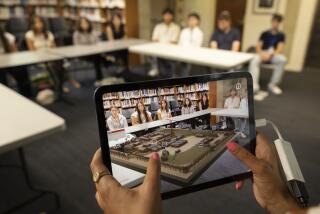Archeology on the Road
- Share via
When the lesson plan called for Thomas Bonasera to teach pre-Columbian culture, he gave his sixth-grade English/social studies students a taste of the real thing by taking them to an archeological dig.
But the excursion to a Mayan temple did not require a voyage to a Central American jungle--the temple came to the playground of his Nightingale Middle School in Cypress Park.
A dozen at a time, the students entered a 48-foot truck trailer and found themselves in the middle of a simulated world, one resembling the ruins of the 1,300-year-old temple.
It’s called the Maya Mobile.
The exterior is decorated with a striking reproduction of a scene from a Mayan vase in which the mythical Hero Twins converse with the Lord of the Underworld. Inside, the walls are lined with simulated tufa stone blocks used by the Mayans as facia for their religious buildings. Canvass awnings and strings of shop-style lights create the ambience of a scientific encampment.
The Maya Mobile, a $1.2-million traveling classroom, is the latest high-tech descendant of a venerable educational institution pioneered in Los Angeles half a century ago--the bookmobile.
Conceived as a means of bringing books to children who did not live within walking distance of a regular library, the bookmobile has endured--and multiplied--since the tomato-red-and-aqua “Parny,” (named for the Greek god Parnassus) made American library history with its 1949 debut here.
Today, the Los Angeles Public Library operates four bookmobiles. But schools in Southern California also get visits from the likes of a stable of Music Mobiles; a Breath Mobile that conducts asthma screening; an Earth Mobile, depicting a Native American archeological site; a Sea Mobile, which simulates a deep-sea dive; and an Art Mobile (see related story below).
The last three--and the new Maya Mobile--are largely the inspiration of Muriel Gluck, the widow of Thoroughbred breeder Maxwell H. Gluck, who moved West after selling his Elmendorff Stables and reputedly filled a penthouse at the Beverly Hills Hotel with trophies.
After her husband’s death, Muriel Gluck began to focus the couple’s charitable foundation on arts and educational causes in San Diego and Los Angeles, including two children’s centers in the Los Angeles school district and a wing of the San Diego Museum of Art.
A decade ago, she conceived of her first traveling classroom, the Art Mobile, which is still operated by the San Diego Museum of Art.
“The whole idea is it comes to their schools, so these children could go and see the museum right there,” Gluck said from her home in Los Angeles. “They can actually see and feel and touch and do something.”
When the Gluck Foundation gave a $1.2-million grant to the Los Angeles County Museum of Art for yet another traveling show, a design team initially toyed with an exhibit on the Silk Road, the trade route from Asia to Europe. But because of the Los Angeles school district’s high percentage of Latino children, museum officials decided that a Mexican-themed exhibit was a better idea. They settled on Mayan culture.
The Maya Mobile, which hit the road this month, is part of the museum’s overall $3.7-million Arts Education Initiative to re-integrate arts instruction into the public schools. Using other grants in addition to the Gluck money, museum officials are creating a teacher academy, workshops, internships and an experimental gallery that will repackage the museum’s collection for young audiences.
*
The look of the Maya Mobile was crafted for authenticity as well as pizazz.
The exterior image of the Hero Twins is a photographic copy from a vase in the collection of the Museum of Fine Arts in Boston. An interior scene of Mayan athletes--playing a ceremonial game that looks something like soccer--comes from a vase at the Museum of Art in St. Louis. A sky painting inside captures the positions of Jupiter and the moon from an evening in AD 587, according to Tim Smith of Promotional Products Inc., which was hired to create the simulation.
Under the tent-like awnings inside are small worktables for the student archeologists. During the Maya Mobile’s inaugural stop at Nightingale, the youngsters sat there as their guide appeared on a video screen built into a temple window. He was a Mayan craftsman transported to downtown Los Angeles, where he seemed bewildered by a plethora of incomprehensible images, from traffic signs to billboards.
He gave the children a challenge: During the next two hours, they would learn some of the symbols of his language--hieroglyphs taken from a codex at their desks--and create ceramic tiles translating some of their symbols into his.
To assist them, there was a real archeologist, Ankarino Lara, a recent Harvard graduate who has hired on as a Mayan interpreter until the next real dig draws him back to Central America.
Each student tried to meet the craftsman’s challenge by drawing icons of American culture--from the Nike shoe insignia to the initials “L.A.”--alongside symbols from the Mayan codex.
After its debut at Nightingale, the Maya Mobile embarked on a four- or five-year tour of Los Angeles middle schools.
What sort of mobile might the students see next?
The Gluck Foundation has something in the works. After plumbing the sea and the earth, why not teach about flight?
Perhaps a . . . NASA Mobile?



